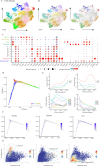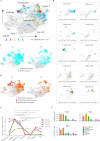Intratumor expanded T cell clones can be non-sentinel lymph node derived in breast cancer revealed by single-cell immune profiling
- PMID: 34992092
- PMCID: PMC8739441
- DOI: 10.1136/jitc-2021-003325
Intratumor expanded T cell clones can be non-sentinel lymph node derived in breast cancer revealed by single-cell immune profiling
Abstract
Background: Sentinel lymph nodes (LNs) are regarded as key immune surveillance sites in cancer wherein mature dendritic cells present tumor-derived antigens to prime and activate T cells, which then migrate to the tumor site. However, it is unclear whether the tumor-specific T cells can be elicited within the tumor independent of the sentinel LNs.
Methods: We performed an integrative analysis of gene expression profiles of 65,285 cells and T cell receptor sequences of 15,831 T cells from 5 paired primary breast tumors and sentinel LNs to identify where clonal T cells come from and the characteristics of those clonal T cells.
Results: The proportion of clonal T cells was higher in the primary tumors compared with the sentinel LNs, whereas all expanded clones identified in the sentinel LN were also present in the primary tumors. In contrast, 10.91% of the expanded clones in the primary tumors were not found in the sentinel LNs. These novel intratumoral T cell clones were characterized by high tissues retention capacity (CXCR6 +ITGAE+) and a distinct coinhibitory pattern (CD39 +NKG2A+) compared with the expanded T cell clones common to both sites. Furthermore, multiplex immunofluorescence imaging showed the presence of tertiary lymphoid structures (TLS) in the primary breast tumors wherein the activated cytolytic T cells were concentrated, indicating its possible role in eliciting non-sentinel LN-derived T cell clones.
Conclusions: Our study revealed expanded intratumor non-sentinel LN derived T cell clones located in the TLS, which points to the need for exploring the role of TLS in antitumor immunity.
Keywords: CD8-positive T-lymphocytes; adaptive immunity; breast neoplasms; immunity.
© Author(s) (or their employer(s)) 2022. Re-use permitted under CC BY-NC. No commercial re-use. See rights and permissions. Published by BMJ.
Conflict of interest statement
Competing interests: None declared.
Figures






References
Publication types
MeSH terms
LinkOut - more resources
Full Text Sources
Medical
Research Materials
